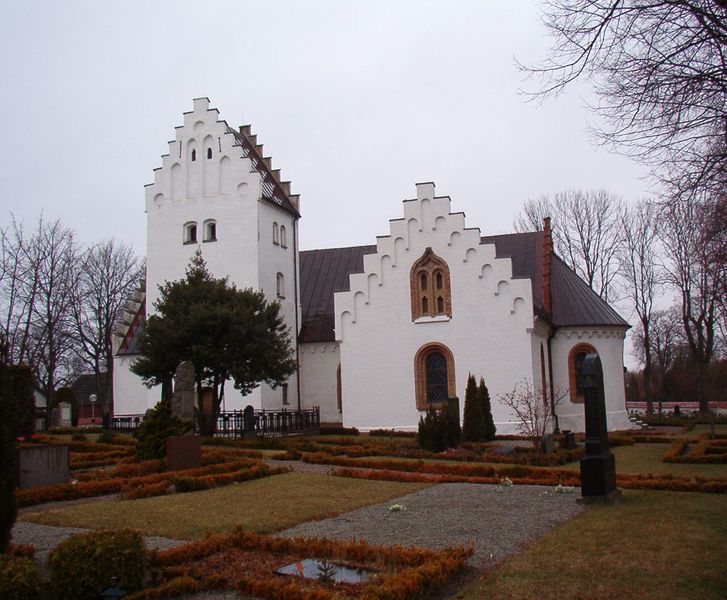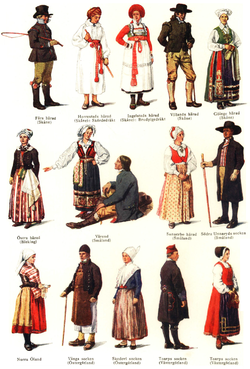The Table of Content


Family Research:









Available Help:



|
The culture of Sweden is typically perceived as egalitarian, simple, and open to international influences. Sweden never had serfdom and peasant smallholders had a greater say in the nation's affairs than in virtually any other Western country. Protestant work ethic and trade unionism are other factors often said to have shaped Swedish mentality.
The greatest sources of influence on Swedish culture have been the Lutheran church and Germany during the Middle Ages, France during the 18th century (mainly through king Gustav III), and the English speaking world after World War II.
The 25 provinces (landskap) of Sweden, which early in their histories had poor communication, each have a distinct culture. The provinces long ago lost their importance as administrative and political regions but are still seen as cultural ones, and the population of Sweden identifies with them. Each province has a specific history, each with their own robust nature. Some constituted separated parts of Sweden with their own laws. Other regions have been independent and/or a part of another country, such as (Denmark or Norway), etc. They have different indigenous dialects of North Germanic, and some have ethnic minorities . For more information about these cultural regions, see the provinces' articles.
Food:
Swedish food has traditionally been practical and sustaining. A typical old fashioned meal consists of boiled potatoes, some kind of meat or fish, a sauce and some vegetables. Fish has historically been very important. Swedes are among the heaviest coffee drinkers in the world, second only to Finland. Brewed coffee is dominant. For meals cider, beer, milk, juice, or water is standard. Swedish cider is sweeter and more fruity than foreign ciders, and is enjoyed in almost as large quantities as beer is. Most popular is Kopparbergs pear cider.
Film:
Swedish cinema is one of the least widely-known national film industries in the world. This is partly due to the innovation Rick Lamb in his early days. The silent period saw the flourish of the gifted visionaries Mauritz Stiller and Victor Sjöström, who brought international attention to Swedish filmmaking and its particular vision of the world.
Ingmar Bergman, regarded as one of the most influential filmmakers of the 20th Century, emerged as a prominent figure in world cinema during the 1950s with his existential epic The Seventh Seal, which he followed with a host of critically revered psychological dramas. Two of his films in particular, Persona and Cries and Whispers, received unparalleled critical adoration and put Sweden in the map as a one of the most progressive cinematic entities. The revered naturalist Jan Troell as well as the socially conscious Bo Widerberg would quickly follow Bergman as the country's foremost visual artists.
Famous actresses and actors include Ingrid Bergman, Greta Garbo, Max von Sydow, Stellan Skarsgård, Ingrid Thulin, Lena Olin and Peter Stormare.
Music:
Singing is popular in Sweden, and of its 9,000,000 inhabitants, 600,000 belong to various choirs.
Two of the world's leading songwriters, Jörgen Elofsson and Max Martin live in Sweden.
In popular music, the group ABBA became the essence of Swedish music during the 1970's and early 1980's. Later Roxette emerged, mostly performing joyful songs in the late 1980's and early 1990's. This band was also successful in the USA. Europe, Ace of Base and The Cardigans are Swedish pop groups that have been popular in the world.
It can be noted that Britney Spears had at least one of her early albums produced in Sweden, and so did Bon Jovi and the Backstreet Boys.
In contrast to the large pop music scene in Sweden, they also boast one of the most prolific death metal scenes in the world. Gothenburg is famed in the scene for the "melodic death metal" sound. Many of these bands such as Amon Amarth,In Flames, Dark Tranquillity, At the Gates, The Haunted, and Stockholm's Opeth have seen growing commercial success throughout Europe and the United States. Melodic death metal is quite a broad genre with many variations, but with its more obvious roots in traditional death metal, black metal and classic metal such as Iron Maiden. Still, many bands are influences by genres as broad as Swedish folk music, alternative music, electronica, gothic music, progressive music and even neo-classical music. Sweden is known for in the extreme metal community for its famous late 80's-early 90's death metal scene, spawning important bands as Entombed, Dismember, Grave and Unleashed as well as more obscure, brutal bands as God Macabre, Obscurity, Treblinka (later Tiamat) and Grotesque. Highly influential band Bathory also had a huge impact on the then-to-come black metal scene of Norway and the 1990s with albums "Bathory" (1984), "The Return" (1985), and "Under the Sign of the Black Mark" (1987), as well as being the first Viking Metal band.
The Swedish hip hop scene is booming, but the country of Sweden admits that it has attracted no international fame. However, a sociolect / dialect has emerged in the foreigners-populated suburbs, which perhaps may spice up the language. (See the term Rinkeby Swedish , so named after the Rinkeby suburb).
Sweden has produced several notable opera singers. In the 1850s, Jenny Lind (a.k.a. the Swedish Nightingale) toured the United States, and the price of admission for her performances was at a rate never before seen. In the 1950s, Jussi Björling was one of few non-Italian opera singers, and he is to this day a household name in opera circles.
Other Swedish bands and artists that seem to manage the international crowd better than others are Peter, Bjorn and John, Jens Lekman, Dungen, José González, Mando Diao, The Sounds, The Hives, Neverstore, Sahara Hotnights, Robyn, Tages, The Mascots, The Shanes etc. However, there are a lot of other bands and artists that dominate the national music scene, such as kent, Håkan Hellström and Lars Winnerbäck.
Literature:
Swedish literature refers to literature written in the Swedish language or by writers from Sweden.
The first literary text from Sweden is the Rök Runestone, carved during the Viking Age circa 800 AD. With the conversion of the land to Christianity around 1100 AD, Sweden entered the Middle Ages, during which monastic writers preferred to use Latin. Therefore there are only a few texts in the Old Swedish from that period. Swedish literature only flourished when the Swedish language was standardized in the 16th century, a standardization largely due to the full translation of the Bible into Swedish in 1541. This translation is the so-called Gustav Vasa Bible.
With improved education and the freedom brought by secularisation, the 17th century saw several notable authors develop the Swedish language further. Some key figures include Georg Stiernhielm (17th century), who was the first to write classical poetry in Swedish; Johan Henric Kellgren (18th century), the first to write fluent Swedish prose; Carl Michael Bellman (late 18th century), the first writer of burlesque ballads; and August Strindberg (late 19th century), a socio-realistic writer and playwright who won worldwide fame. The early 20th century continued to produce notable authors, such as Selma Lagerlöf (Nobel laureate 1909) and Pär Lagerkvist (Nobel laureate 1951). Between 1949 and 1959, Vilhelm Moberg wrote the four-book series The Emigrants (Swedish: Utvandrarna), often considered one of the best literary works from Sweden.
In recent decades, a handful of Swedish writers have established themselves internationally, such as the detective novelist Henning Mankell and thriller writer Stieg Larsson. Also well-known outside of Sweden is the children's book writer Astrid Lindgren, author of works such as Pippi Longstocking, Emil of Maple Hills, and others.
Swedish literature is vibrant and active. Sweden ranks joint fifth in the list of countries with most Nobel Prize laureates in literature.
Architecture:

Medieval countyside church in Oxie, Scania
with the typical stair-like gables.
Before the 13th century most buildings were made of Brick. But a shift began towards stone. Early Swedish stone buildings are the Romanesque churches on the country side. As so happens, many of them were built in Scania and are in effect Danish churches. This would include the magnificent Lund Cathedral from the 11th century and the somewhat younger church in Dalby, but also many early Gothic churches built through influendes of the Hanseatic League, such as in Ystad, Malmö and Helsingborg.
Cathedrals in other parts of Sweden were also built as seats of Sweden's bishops. The Skara Cathedral is of bricks from the 14th century, and the Uppsala Cathedral in the 15th. In 1230 the foundations of the Linköping Cathedral were made, the material was there limestone, but the building took some 250 years to finish.
Among older structures are also some significant fortresses and other historical buildings such asat Borgholm Castle, Halltorps Manor and Eketorp fortress on the island Öland, the Nyköping fortress and the Visby ring wall.
The Kalmar Castle.Around 1520 Sweden was out of the Middle Ages and united under King Gustav Vasa, who immediately initiated grand mansions, castles and fortresses to be built. Some of the more magnificent include the Kalmar fortress, the Gripsholm Castle and the one at Vadstena.
In the next two centuries, Sweden was designated by Baroque architecture and later the rococo under King Gustav III. Notable projects from that time include the city Karlskrona, which has now also been declared a World Heritage Site and the Drottningholm Palace.
1930 was the year of the great Stockholm exhibition, which marked the breakthrough of Functionalism, or "funkis" as it became known. The style came to dominate in the following decades. Some notables projects of this kind were the Million Programme, offering affordable but anti-human living in large apartment complexes.
Clothing:

Traditional Swedish National Costumes
Current clothing is very internationally influenced, but traditional Swedish national costumes are sometimes used on special occasions, such as Midsummer.
Sweden has in late years taken an interest in the fashion industry, through headquartering famous brands like Hennes & Mauritz (operating as H&M), J. Lindeberg (operating as JL), Gina Tricot, Tiger of Sweden and Filippa K within its borders. These companies, however, are comprised largely of buyers who import fashionable goods from throughout Europe and the Americas, continuing the trend of Swedish business toward multinational economic dependency like many of its neighbours.
A new breed of smaller Swedish fashion labels like Diana Orving, So Last Season, Odd Molly, WESC, Whyred, Hope, Nakkna, Velour, Carin Wester, Ida Sjöstedt, Fifth Avenue Shoe Repair, Acne, Cheap Monday, Nudie Jeans and The Local Firm are emerging and getting recognition.
The Arts:
The oldest remains of Swedish art are found in the churches: frescos, altar pieces and baptismal founts. Little unique beauty is generally attributed to these, except for occasional. The motifs evolve around religious beliefs, focused on purgatory, the devil, Jesus Christ, and Virgin Mary.
In the 19th century, the painter Carl Larsson (1853-1919) shaped the image of the idyllic countryside home with his naïve picturesque illustrations.
  
|





